Sociology Assignment: Social Exclusion, Class, and Well-being
VerifiedAdded on 2022/12/26
|10
|2687
|90
Essay
AI Summary
This sociology assignment examines the functions of education, religion, health, and employment within Australian society, highlighting their impact on individuals and communities. It identifies factors contributing to the social exclusion of older individuals, Aboriginal and Torres Strait Islanders, and people with disabilities, focusing on the psychological and economic consequences of this exclusion. The assignment also analyzes the impact of social class structures on health, access to care, and life expectancy, discussing different social classes in Australia, including the established affluent, emergent affluent, mobile middle, established middle, established working, and precariat. Finally, it explores policies addressing inequality and social exclusion within the Australian context. This assignment provides a comprehensive overview of key sociological issues in Australia.
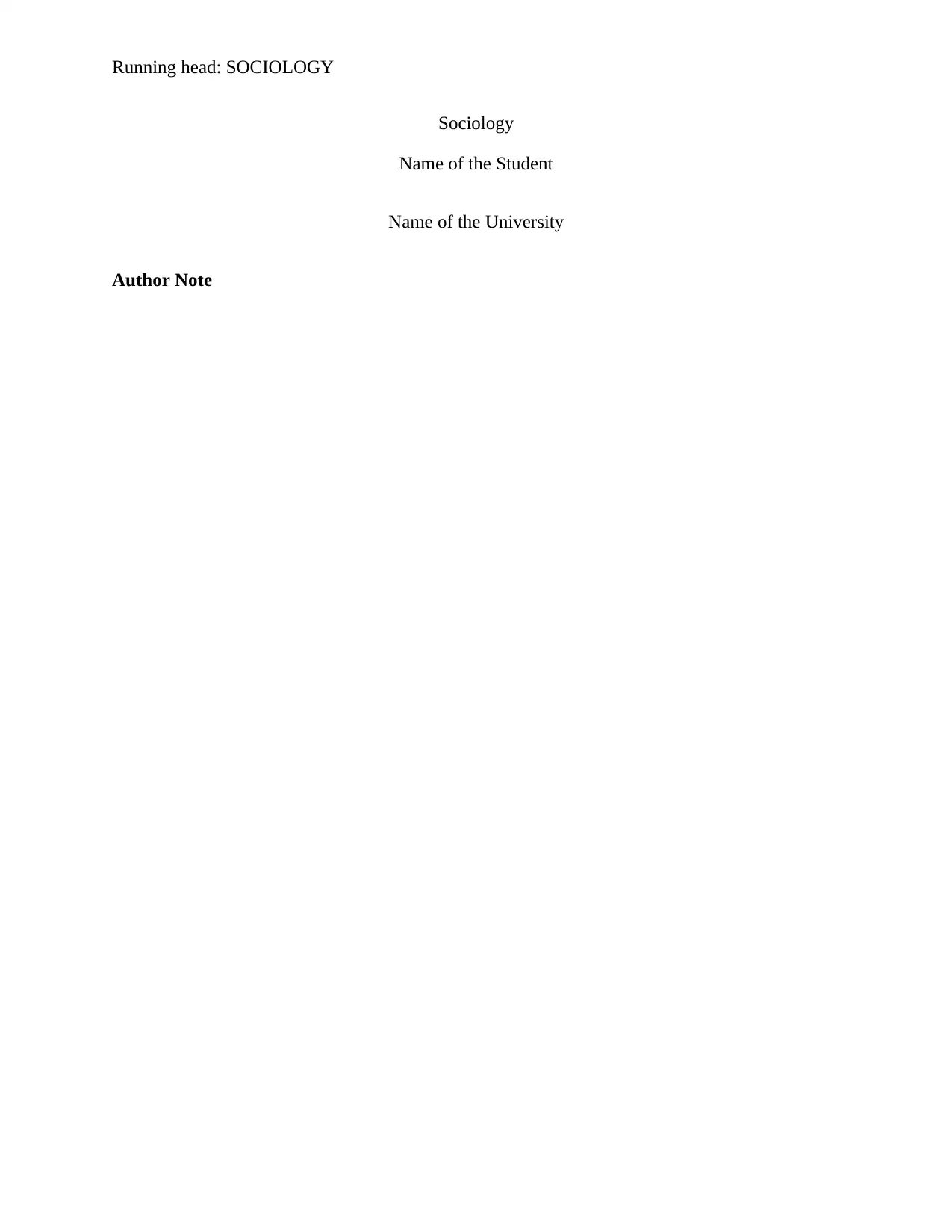
Running head: SOCIOLOGY
Sociology
Name of the Student
Name of the University
Author Note
Sociology
Name of the Student
Name of the University
Author Note
Paraphrase This Document
Need a fresh take? Get an instant paraphrase of this document with our AI Paraphraser

1SOCIOLOGY
Part 1
Identification of the function of Education, religion, health and employment in the society
Education, in the Australian society holds a major position since it inculcate values,
norms as well as social skills that enhances both theoretical as well as practical knowledge of the
children and makes them ready for their role as adults in the society. The council of Australian
Government has declared the importance of greater education as well as training participation in
order to ensure that majority of the residents of the nation are contributing to as well as getting
benefited from the prosperity of the nation (Park, 2017). When it comes to the function of health
institutions in Australia, the primary function of the same is to ensure that all the members of the
society are leading a healthy and disease free lifestyle. Australia, like Canada, offers its residents
with free healthcare system. The chief function of the health institution in the Australian society
is to build the workforce requires to staff key national public health institutions, conduct the core
functions of the public health as well as implement and manage critical healthcare programs.
When it comes to the function of religion in the mentioned society, it includes
maintaining social solidarity as well as value consensus amongst the population of the society
along with helping maintaining the well being of the society (MacDonald, 2017). The chief role
of the employment institutions is to recruit members from the society who are eligible for a
specific job role. Along with this, this institution is highly crucial since it contributes hugely to
the economic growth of the Australian society. Employees produce valuable products as well as
services and in turn receive wages that helps them to maintain an healthy lifestyle.
Identification of the impact of the cultural institution on the client as an individual and as a
part of the community
Part 1
Identification of the function of Education, religion, health and employment in the society
Education, in the Australian society holds a major position since it inculcate values,
norms as well as social skills that enhances both theoretical as well as practical knowledge of the
children and makes them ready for their role as adults in the society. The council of Australian
Government has declared the importance of greater education as well as training participation in
order to ensure that majority of the residents of the nation are contributing to as well as getting
benefited from the prosperity of the nation (Park, 2017). When it comes to the function of health
institutions in Australia, the primary function of the same is to ensure that all the members of the
society are leading a healthy and disease free lifestyle. Australia, like Canada, offers its residents
with free healthcare system. The chief function of the health institution in the Australian society
is to build the workforce requires to staff key national public health institutions, conduct the core
functions of the public health as well as implement and manage critical healthcare programs.
When it comes to the function of religion in the mentioned society, it includes
maintaining social solidarity as well as value consensus amongst the population of the society
along with helping maintaining the well being of the society (MacDonald, 2017). The chief role
of the employment institutions is to recruit members from the society who are eligible for a
specific job role. Along with this, this institution is highly crucial since it contributes hugely to
the economic growth of the Australian society. Employees produce valuable products as well as
services and in turn receive wages that helps them to maintain an healthy lifestyle.
Identification of the impact of the cultural institution on the client as an individual and as a
part of the community
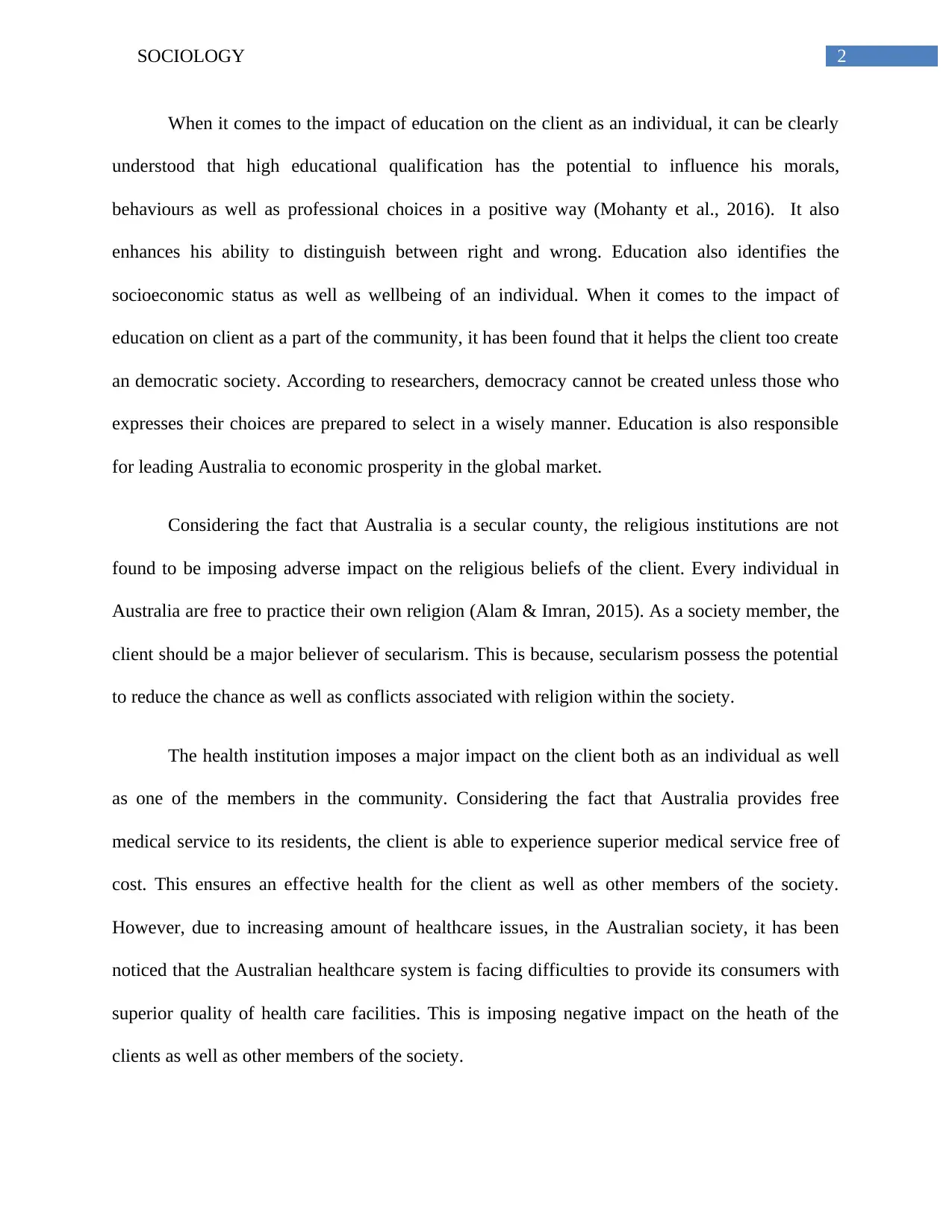
2SOCIOLOGY
When it comes to the impact of education on the client as an individual, it can be clearly
understood that high educational qualification has the potential to influence his morals,
behaviours as well as professional choices in a positive way (Mohanty et al., 2016). It also
enhances his ability to distinguish between right and wrong. Education also identifies the
socioeconomic status as well as wellbeing of an individual. When it comes to the impact of
education on client as a part of the community, it has been found that it helps the client too create
an democratic society. According to researchers, democracy cannot be created unless those who
expresses their choices are prepared to select in a wisely manner. Education is also responsible
for leading Australia to economic prosperity in the global market.
Considering the fact that Australia is a secular county, the religious institutions are not
found to be imposing adverse impact on the religious beliefs of the client. Every individual in
Australia are free to practice their own religion (Alam & Imran, 2015). As a society member, the
client should be a major believer of secularism. This is because, secularism possess the potential
to reduce the chance as well as conflicts associated with religion within the society.
The health institution imposes a major impact on the client both as an individual as well
as one of the members in the community. Considering the fact that Australia provides free
medical service to its residents, the client is able to experience superior medical service free of
cost. This ensures an effective health for the client as well as other members of the society.
However, due to increasing amount of healthcare issues, in the Australian society, it has been
noticed that the Australian healthcare system is facing difficulties to provide its consumers with
superior quality of health care facilities. This is imposing negative impact on the heath of the
clients as well as other members of the society.
When it comes to the impact of education on the client as an individual, it can be clearly
understood that high educational qualification has the potential to influence his morals,
behaviours as well as professional choices in a positive way (Mohanty et al., 2016). It also
enhances his ability to distinguish between right and wrong. Education also identifies the
socioeconomic status as well as wellbeing of an individual. When it comes to the impact of
education on client as a part of the community, it has been found that it helps the client too create
an democratic society. According to researchers, democracy cannot be created unless those who
expresses their choices are prepared to select in a wisely manner. Education is also responsible
for leading Australia to economic prosperity in the global market.
Considering the fact that Australia is a secular county, the religious institutions are not
found to be imposing adverse impact on the religious beliefs of the client. Every individual in
Australia are free to practice their own religion (Alam & Imran, 2015). As a society member, the
client should be a major believer of secularism. This is because, secularism possess the potential
to reduce the chance as well as conflicts associated with religion within the society.
The health institution imposes a major impact on the client both as an individual as well
as one of the members in the community. Considering the fact that Australia provides free
medical service to its residents, the client is able to experience superior medical service free of
cost. This ensures an effective health for the client as well as other members of the society.
However, due to increasing amount of healthcare issues, in the Australian society, it has been
noticed that the Australian healthcare system is facing difficulties to provide its consumers with
superior quality of health care facilities. This is imposing negative impact on the heath of the
clients as well as other members of the society.
⊘ This is a preview!⊘
Do you want full access?
Subscribe today to unlock all pages.

Trusted by 1+ million students worldwide
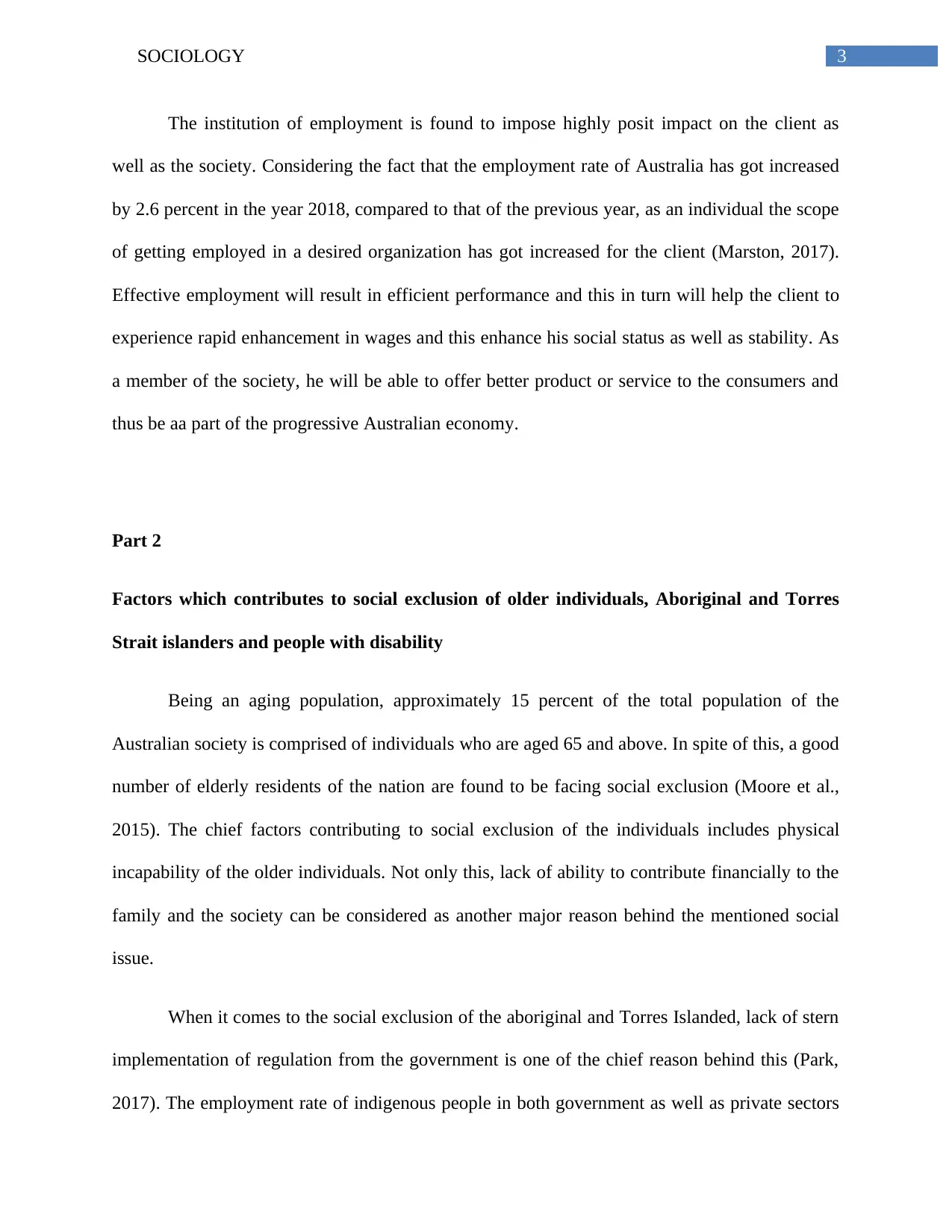
3SOCIOLOGY
The institution of employment is found to impose highly posit impact on the client as
well as the society. Considering the fact that the employment rate of Australia has got increased
by 2.6 percent in the year 2018, compared to that of the previous year, as an individual the scope
of getting employed in a desired organization has got increased for the client (Marston, 2017).
Effective employment will result in efficient performance and this in turn will help the client to
experience rapid enhancement in wages and this enhance his social status as well as stability. As
a member of the society, he will be able to offer better product or service to the consumers and
thus be aa part of the progressive Australian economy.
Part 2
Factors which contributes to social exclusion of older individuals, Aboriginal and Torres
Strait islanders and people with disability
Being an aging population, approximately 15 percent of the total population of the
Australian society is comprised of individuals who are aged 65 and above. In spite of this, a good
number of elderly residents of the nation are found to be facing social exclusion (Moore et al.,
2015). The chief factors contributing to social exclusion of the individuals includes physical
incapability of the older individuals. Not only this, lack of ability to contribute financially to the
family and the society can be considered as another major reason behind the mentioned social
issue.
When it comes to the social exclusion of the aboriginal and Torres Islanded, lack of stern
implementation of regulation from the government is one of the chief reason behind this (Park,
2017). The employment rate of indigenous people in both government as well as private sectors
The institution of employment is found to impose highly posit impact on the client as
well as the society. Considering the fact that the employment rate of Australia has got increased
by 2.6 percent in the year 2018, compared to that of the previous year, as an individual the scope
of getting employed in a desired organization has got increased for the client (Marston, 2017).
Effective employment will result in efficient performance and this in turn will help the client to
experience rapid enhancement in wages and this enhance his social status as well as stability. As
a member of the society, he will be able to offer better product or service to the consumers and
thus be aa part of the progressive Australian economy.
Part 2
Factors which contributes to social exclusion of older individuals, Aboriginal and Torres
Strait islanders and people with disability
Being an aging population, approximately 15 percent of the total population of the
Australian society is comprised of individuals who are aged 65 and above. In spite of this, a good
number of elderly residents of the nation are found to be facing social exclusion (Moore et al.,
2015). The chief factors contributing to social exclusion of the individuals includes physical
incapability of the older individuals. Not only this, lack of ability to contribute financially to the
family and the society can be considered as another major reason behind the mentioned social
issue.
When it comes to the social exclusion of the aboriginal and Torres Islanded, lack of stern
implementation of regulation from the government is one of the chief reason behind this (Park,
2017). The employment rate of indigenous people in both government as well as private sectors
Paraphrase This Document
Need a fresh take? Get an instant paraphrase of this document with our AI Paraphraser
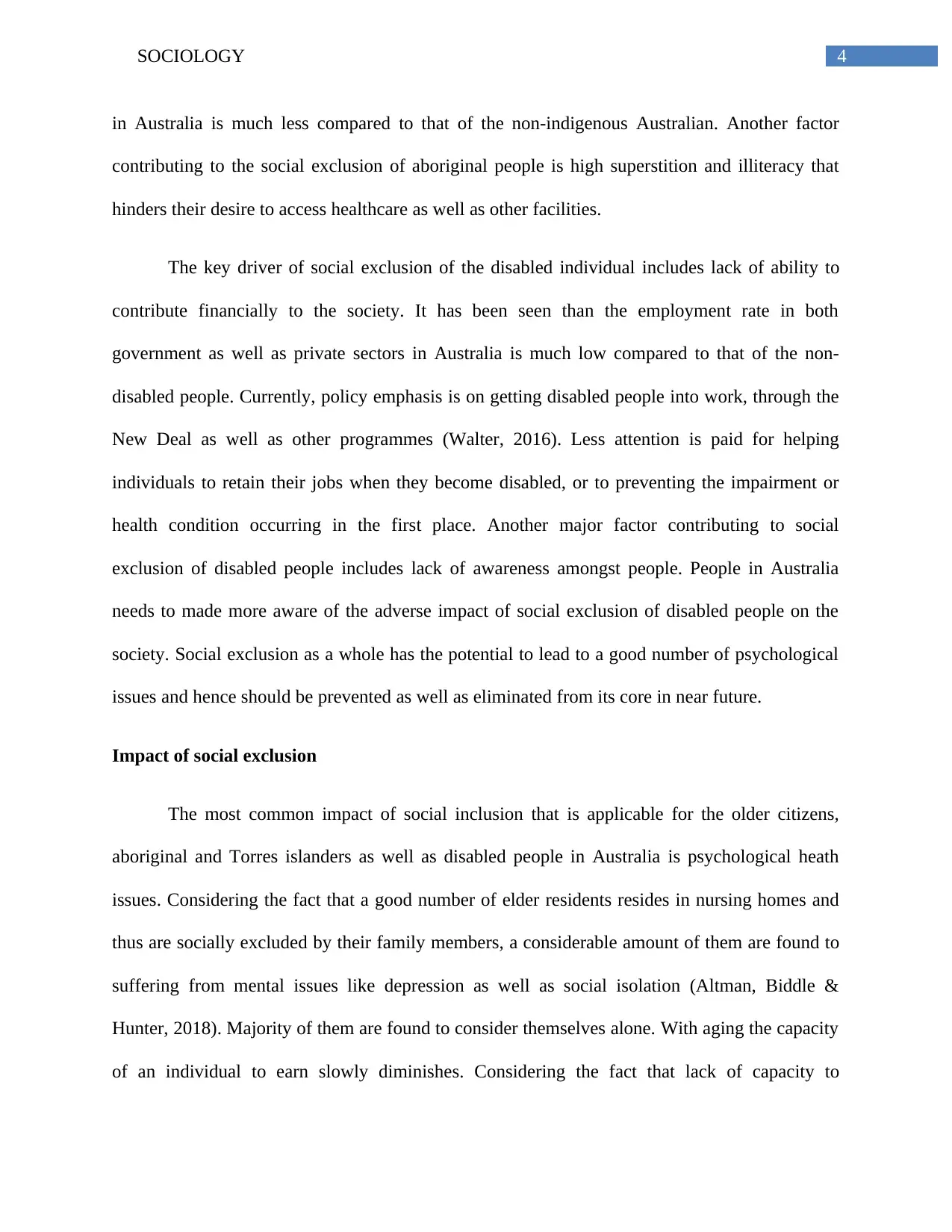
4SOCIOLOGY
in Australia is much less compared to that of the non-indigenous Australian. Another factor
contributing to the social exclusion of aboriginal people is high superstition and illiteracy that
hinders their desire to access healthcare as well as other facilities.
The key driver of social exclusion of the disabled individual includes lack of ability to
contribute financially to the society. It has been seen than the employment rate in both
government as well as private sectors in Australia is much low compared to that of the non-
disabled people. Currently, policy emphasis is on getting disabled people into work, through the
New Deal as well as other programmes (Walter, 2016). Less attention is paid for helping
individuals to retain their jobs when they become disabled, or to preventing the impairment or
health condition occurring in the first place. Another major factor contributing to social
exclusion of disabled people includes lack of awareness amongst people. People in Australia
needs to made more aware of the adverse impact of social exclusion of disabled people on the
society. Social exclusion as a whole has the potential to lead to a good number of psychological
issues and hence should be prevented as well as eliminated from its core in near future.
Impact of social exclusion
The most common impact of social inclusion that is applicable for the older citizens,
aboriginal and Torres islanders as well as disabled people in Australia is psychological heath
issues. Considering the fact that a good number of elder residents resides in nursing homes and
thus are socially excluded by their family members, a considerable amount of them are found to
suffering from mental issues like depression as well as social isolation (Altman, Biddle &
Hunter, 2018). Majority of them are found to consider themselves alone. With aging the capacity
of an individual to earn slowly diminishes. Considering the fact that lack of capacity to
in Australia is much less compared to that of the non-indigenous Australian. Another factor
contributing to the social exclusion of aboriginal people is high superstition and illiteracy that
hinders their desire to access healthcare as well as other facilities.
The key driver of social exclusion of the disabled individual includes lack of ability to
contribute financially to the society. It has been seen than the employment rate in both
government as well as private sectors in Australia is much low compared to that of the non-
disabled people. Currently, policy emphasis is on getting disabled people into work, through the
New Deal as well as other programmes (Walter, 2016). Less attention is paid for helping
individuals to retain their jobs when they become disabled, or to preventing the impairment or
health condition occurring in the first place. Another major factor contributing to social
exclusion of disabled people includes lack of awareness amongst people. People in Australia
needs to made more aware of the adverse impact of social exclusion of disabled people on the
society. Social exclusion as a whole has the potential to lead to a good number of psychological
issues and hence should be prevented as well as eliminated from its core in near future.
Impact of social exclusion
The most common impact of social inclusion that is applicable for the older citizens,
aboriginal and Torres islanders as well as disabled people in Australia is psychological heath
issues. Considering the fact that a good number of elder residents resides in nursing homes and
thus are socially excluded by their family members, a considerable amount of them are found to
suffering from mental issues like depression as well as social isolation (Altman, Biddle &
Hunter, 2018). Majority of them are found to consider themselves alone. With aging the capacity
of an individual to earn slowly diminishes. Considering the fact that lack of capacity to
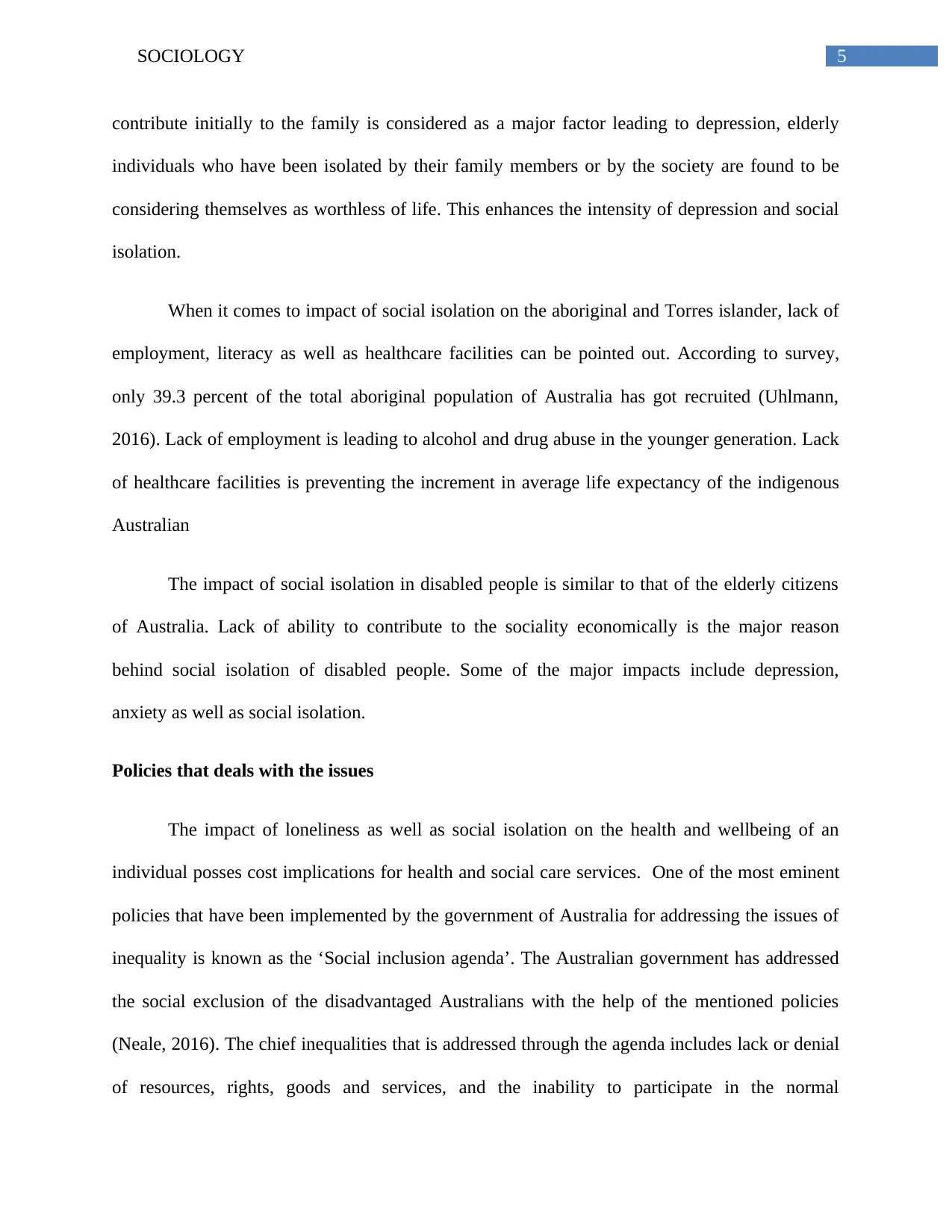
5SOCIOLOGY
contribute initially to the family is considered as a major factor leading to depression, elderly
individuals who have been isolated by their family members or by the society are found to be
considering themselves as worthless of life. This enhances the intensity of depression and social
isolation.
When it comes to impact of social isolation on the aboriginal and Torres islander, lack of
employment, literacy as well as healthcare facilities can be pointed out. According to survey,
only 39.3 percent of the total aboriginal population of Australia has got recruited (Uhlmann,
2016). Lack of employment is leading to alcohol and drug abuse in the younger generation. Lack
of healthcare facilities is preventing the increment in average life expectancy of the indigenous
Australian
The impact of social isolation in disabled people is similar to that of the elderly citizens
of Australia. Lack of ability to contribute to the sociality economically is the major reason
behind social isolation of disabled people. Some of the major impacts include depression,
anxiety as well as social isolation.
Policies that deals with the issues
The impact of loneliness as well as social isolation on the health and wellbeing of an
individual posses cost implications for health and social care services. One of the most eminent
policies that have been implemented by the government of Australia for addressing the issues of
inequality is known as the ‘Social inclusion agenda’. The Australian government has addressed
the social exclusion of the disadvantaged Australians with the help of the mentioned policies
(Neale, 2016). The chief inequalities that is addressed through the agenda includes lack or denial
of resources, rights, goods and services, and the inability to participate in the normal
contribute initially to the family is considered as a major factor leading to depression, elderly
individuals who have been isolated by their family members or by the society are found to be
considering themselves as worthless of life. This enhances the intensity of depression and social
isolation.
When it comes to impact of social isolation on the aboriginal and Torres islander, lack of
employment, literacy as well as healthcare facilities can be pointed out. According to survey,
only 39.3 percent of the total aboriginal population of Australia has got recruited (Uhlmann,
2016). Lack of employment is leading to alcohol and drug abuse in the younger generation. Lack
of healthcare facilities is preventing the increment in average life expectancy of the indigenous
Australian
The impact of social isolation in disabled people is similar to that of the elderly citizens
of Australia. Lack of ability to contribute to the sociality economically is the major reason
behind social isolation of disabled people. Some of the major impacts include depression,
anxiety as well as social isolation.
Policies that deals with the issues
The impact of loneliness as well as social isolation on the health and wellbeing of an
individual posses cost implications for health and social care services. One of the most eminent
policies that have been implemented by the government of Australia for addressing the issues of
inequality is known as the ‘Social inclusion agenda’. The Australian government has addressed
the social exclusion of the disadvantaged Australians with the help of the mentioned policies
(Neale, 2016). The chief inequalities that is addressed through the agenda includes lack or denial
of resources, rights, goods and services, and the inability to participate in the normal
⊘ This is a preview!⊘
Do you want full access?
Subscribe today to unlock all pages.

Trusted by 1+ million students worldwide
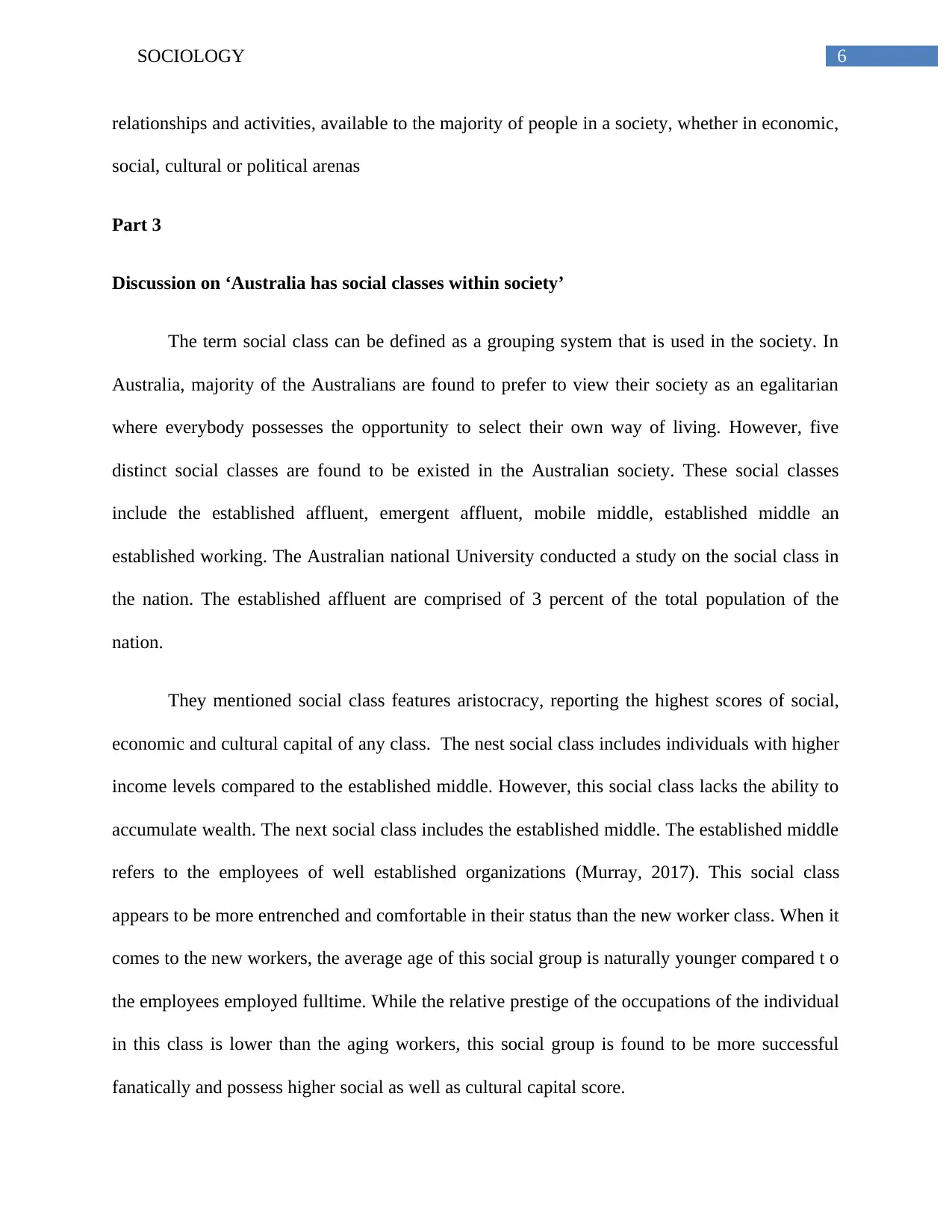
6SOCIOLOGY
relationships and activities, available to the majority of people in a society, whether in economic,
social, cultural or political arenas
Part 3
Discussion on ‘Australia has social classes within society’
The term social class can be defined as a grouping system that is used in the society. In
Australia, majority of the Australians are found to prefer to view their society as an egalitarian
where everybody possesses the opportunity to select their own way of living. However, five
distinct social classes are found to be existed in the Australian society. These social classes
include the established affluent, emergent affluent, mobile middle, established middle an
established working. The Australian national University conducted a study on the social class in
the nation. The established affluent are comprised of 3 percent of the total population of the
nation.
They mentioned social class features aristocracy, reporting the highest scores of social,
economic and cultural capital of any class. The nest social class includes individuals with higher
income levels compared to the established middle. However, this social class lacks the ability to
accumulate wealth. The next social class includes the established middle. The established middle
refers to the employees of well established organizations (Murray, 2017). This social class
appears to be more entrenched and comfortable in their status than the new worker class. When it
comes to the new workers, the average age of this social group is naturally younger compared t o
the employees employed fulltime. While the relative prestige of the occupations of the individual
in this class is lower than the aging workers, this social group is found to be more successful
fanatically and possess higher social as well as cultural capital score.
relationships and activities, available to the majority of people in a society, whether in economic,
social, cultural or political arenas
Part 3
Discussion on ‘Australia has social classes within society’
The term social class can be defined as a grouping system that is used in the society. In
Australia, majority of the Australians are found to prefer to view their society as an egalitarian
where everybody possesses the opportunity to select their own way of living. However, five
distinct social classes are found to be existed in the Australian society. These social classes
include the established affluent, emergent affluent, mobile middle, established middle an
established working. The Australian national University conducted a study on the social class in
the nation. The established affluent are comprised of 3 percent of the total population of the
nation.
They mentioned social class features aristocracy, reporting the highest scores of social,
economic and cultural capital of any class. The nest social class includes individuals with higher
income levels compared to the established middle. However, this social class lacks the ability to
accumulate wealth. The next social class includes the established middle. The established middle
refers to the employees of well established organizations (Murray, 2017). This social class
appears to be more entrenched and comfortable in their status than the new worker class. When it
comes to the new workers, the average age of this social group is naturally younger compared t o
the employees employed fulltime. While the relative prestige of the occupations of the individual
in this class is lower than the aging workers, this social group is found to be more successful
fanatically and possess higher social as well as cultural capital score.
Paraphrase This Document
Need a fresh take? Get an instant paraphrase of this document with our AI Paraphraser
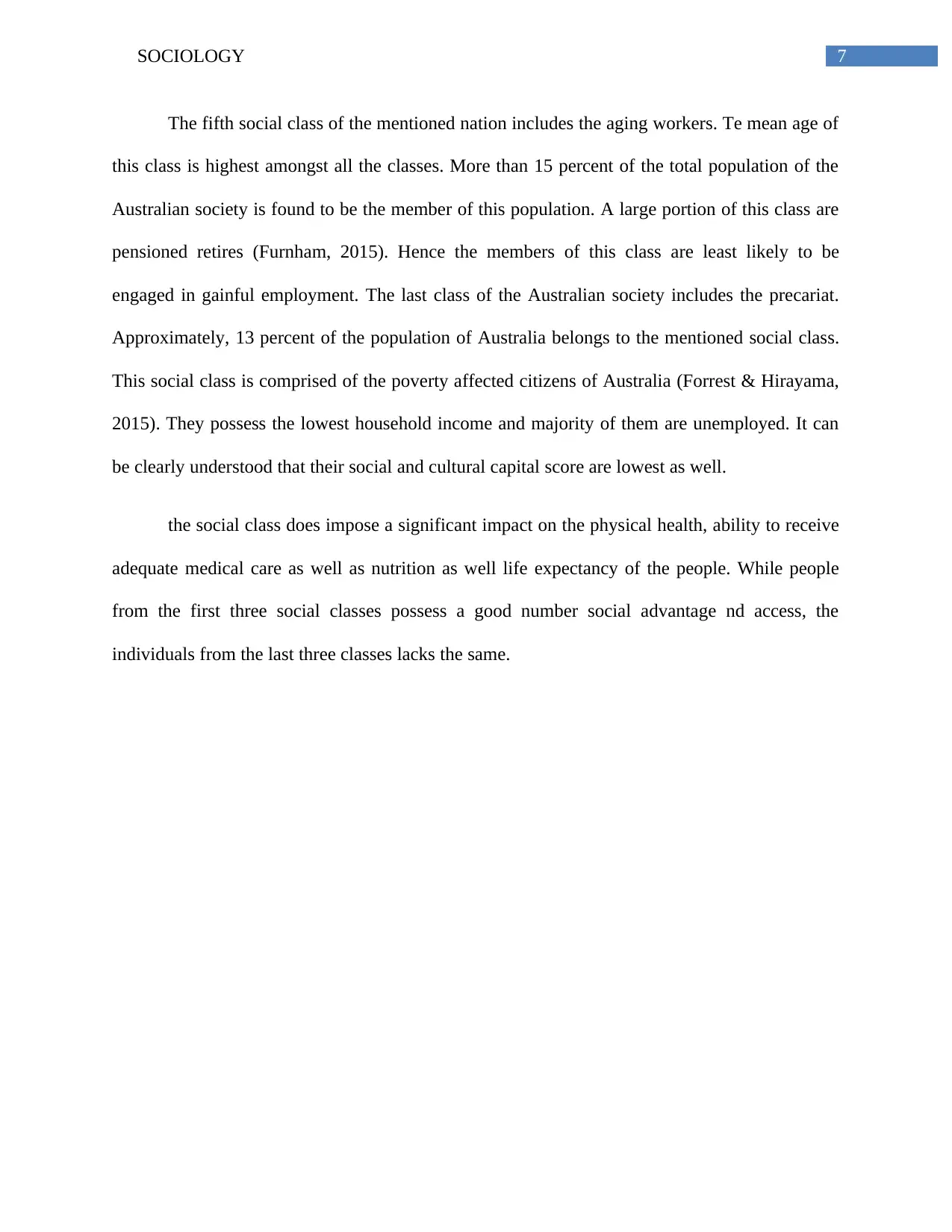
7SOCIOLOGY
The fifth social class of the mentioned nation includes the aging workers. Te mean age of
this class is highest amongst all the classes. More than 15 percent of the total population of the
Australian society is found to be the member of this population. A large portion of this class are
pensioned retires (Furnham, 2015). Hence the members of this class are least likely to be
engaged in gainful employment. The last class of the Australian society includes the precariat.
Approximately, 13 percent of the population of Australia belongs to the mentioned social class.
This social class is comprised of the poverty affected citizens of Australia (Forrest & Hirayama,
2015). They possess the lowest household income and majority of them are unemployed. It can
be clearly understood that their social and cultural capital score are lowest as well.
the social class does impose a significant impact on the physical health, ability to receive
adequate medical care as well as nutrition as well life expectancy of the people. While people
from the first three social classes possess a good number social advantage nd access, the
individuals from the last three classes lacks the same.
The fifth social class of the mentioned nation includes the aging workers. Te mean age of
this class is highest amongst all the classes. More than 15 percent of the total population of the
Australian society is found to be the member of this population. A large portion of this class are
pensioned retires (Furnham, 2015). Hence the members of this class are least likely to be
engaged in gainful employment. The last class of the Australian society includes the precariat.
Approximately, 13 percent of the population of Australia belongs to the mentioned social class.
This social class is comprised of the poverty affected citizens of Australia (Forrest & Hirayama,
2015). They possess the lowest household income and majority of them are unemployed. It can
be clearly understood that their social and cultural capital score are lowest as well.
the social class does impose a significant impact on the physical health, ability to receive
adequate medical care as well as nutrition as well life expectancy of the people. While people
from the first three social classes possess a good number social advantage nd access, the
individuals from the last three classes lacks the same.
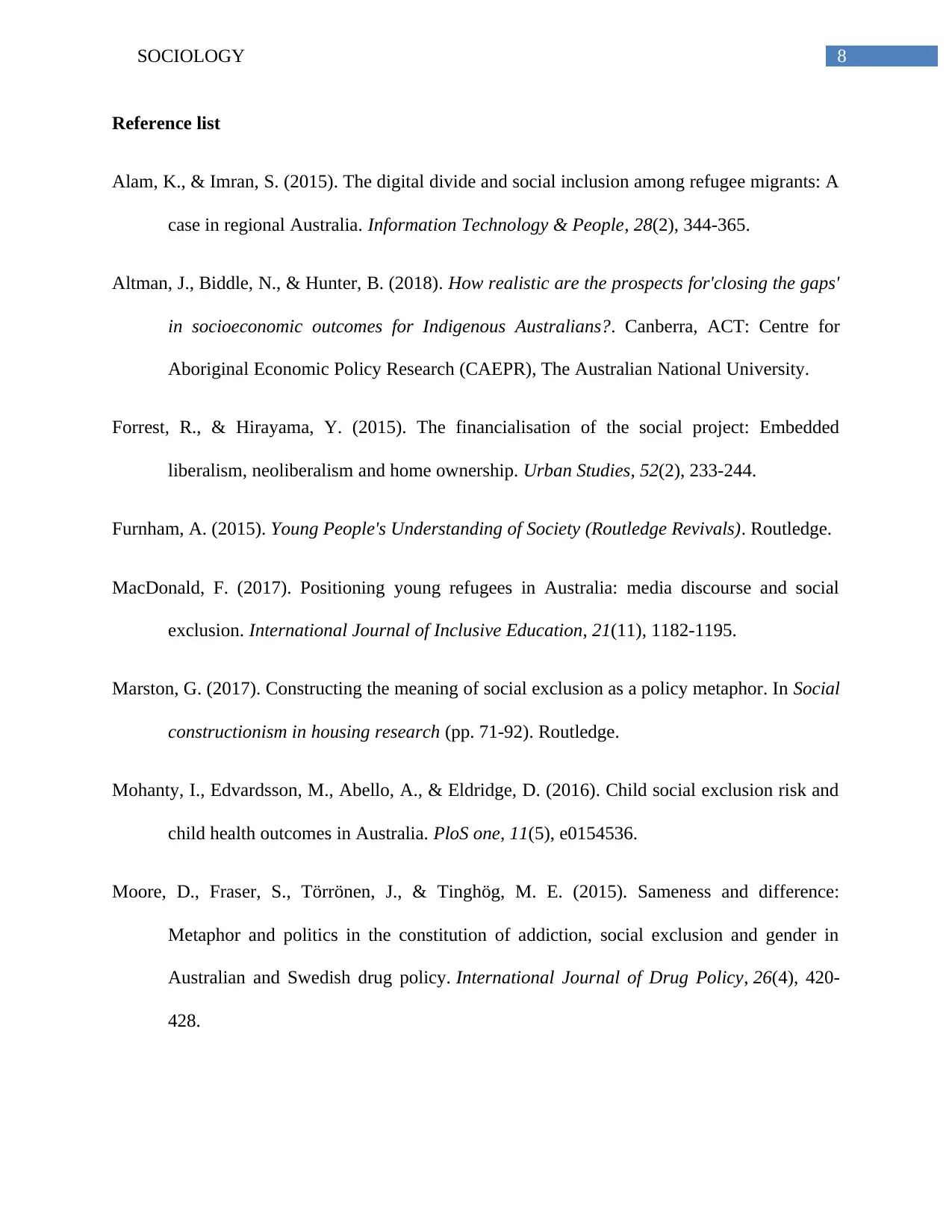
8SOCIOLOGY
Reference list
Alam, K., & Imran, S. (2015). The digital divide and social inclusion among refugee migrants: A
case in regional Australia. Information Technology & People, 28(2), 344-365.
Altman, J., Biddle, N., & Hunter, B. (2018). How realistic are the prospects for'closing the gaps'
in socioeconomic outcomes for Indigenous Australians?. Canberra, ACT: Centre for
Aboriginal Economic Policy Research (CAEPR), The Australian National University.
Forrest, R., & Hirayama, Y. (2015). The financialisation of the social project: Embedded
liberalism, neoliberalism and home ownership. Urban Studies, 52(2), 233-244.
Furnham, A. (2015). Young People's Understanding of Society (Routledge Revivals). Routledge.
MacDonald, F. (2017). Positioning young refugees in Australia: media discourse and social
exclusion. International Journal of Inclusive Education, 21(11), 1182-1195.
Marston, G. (2017). Constructing the meaning of social exclusion as a policy metaphor. In Social
constructionism in housing research (pp. 71-92). Routledge.
Mohanty, I., Edvardsson, M., Abello, A., & Eldridge, D. (2016). Child social exclusion risk and
child health outcomes in Australia. PloS one, 11(5), e0154536.
Moore, D., Fraser, S., Törrönen, J., & Tinghög, M. E. (2015). Sameness and difference:
Metaphor and politics in the constitution of addiction, social exclusion and gender in
Australian and Swedish drug policy. International Journal of Drug Policy, 26(4), 420-
428.
Reference list
Alam, K., & Imran, S. (2015). The digital divide and social inclusion among refugee migrants: A
case in regional Australia. Information Technology & People, 28(2), 344-365.
Altman, J., Biddle, N., & Hunter, B. (2018). How realistic are the prospects for'closing the gaps'
in socioeconomic outcomes for Indigenous Australians?. Canberra, ACT: Centre for
Aboriginal Economic Policy Research (CAEPR), The Australian National University.
Forrest, R., & Hirayama, Y. (2015). The financialisation of the social project: Embedded
liberalism, neoliberalism and home ownership. Urban Studies, 52(2), 233-244.
Furnham, A. (2015). Young People's Understanding of Society (Routledge Revivals). Routledge.
MacDonald, F. (2017). Positioning young refugees in Australia: media discourse and social
exclusion. International Journal of Inclusive Education, 21(11), 1182-1195.
Marston, G. (2017). Constructing the meaning of social exclusion as a policy metaphor. In Social
constructionism in housing research (pp. 71-92). Routledge.
Mohanty, I., Edvardsson, M., Abello, A., & Eldridge, D. (2016). Child social exclusion risk and
child health outcomes in Australia. PloS one, 11(5), e0154536.
Moore, D., Fraser, S., Törrönen, J., & Tinghög, M. E. (2015). Sameness and difference:
Metaphor and politics in the constitution of addiction, social exclusion and gender in
Australian and Swedish drug policy. International Journal of Drug Policy, 26(4), 420-
428.
⊘ This is a preview!⊘
Do you want full access?
Subscribe today to unlock all pages.

Trusted by 1+ million students worldwide
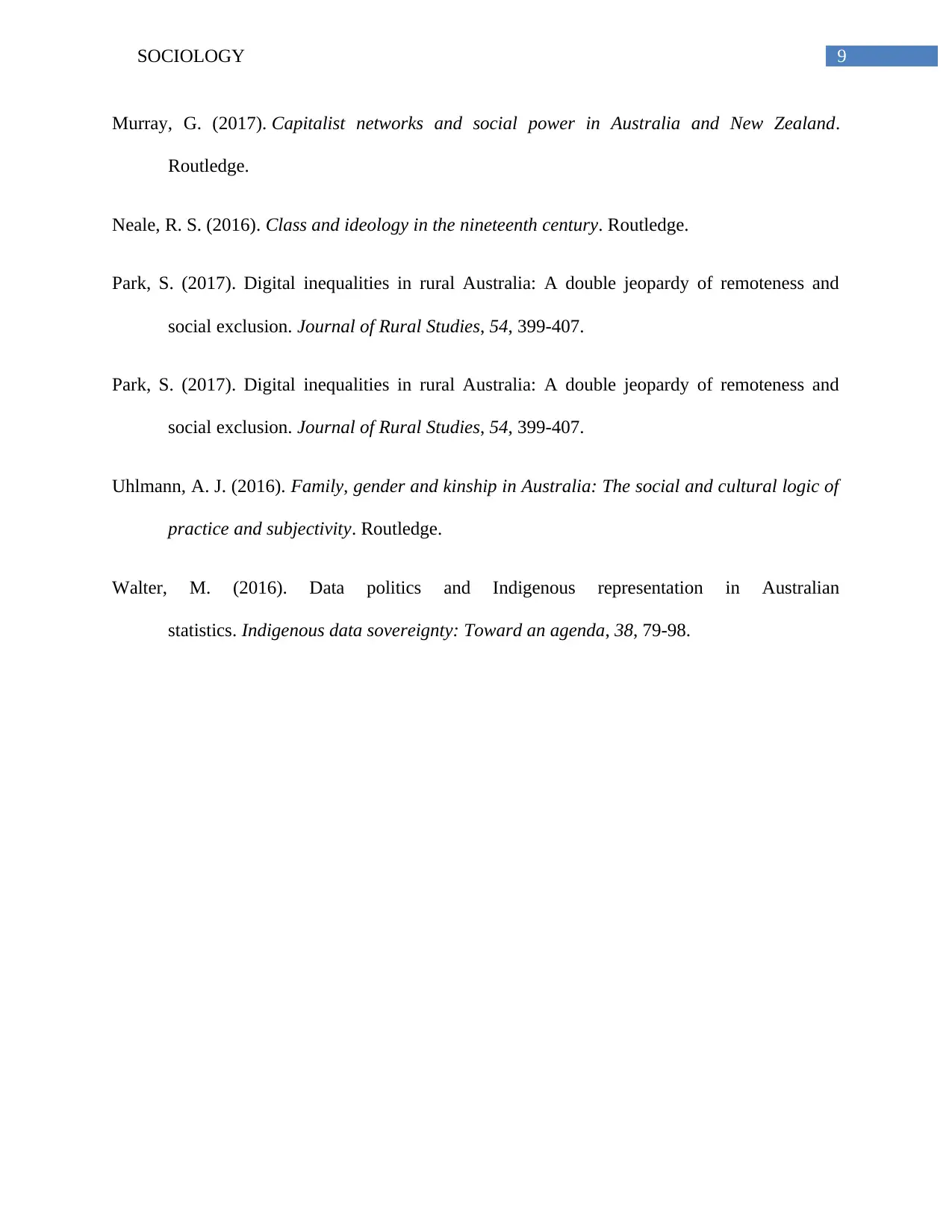
9SOCIOLOGY
Murray, G. (2017). Capitalist networks and social power in Australia and New Zealand.
Routledge.
Neale, R. S. (2016). Class and ideology in the nineteenth century. Routledge.
Park, S. (2017). Digital inequalities in rural Australia: A double jeopardy of remoteness and
social exclusion. Journal of Rural Studies, 54, 399-407.
Park, S. (2017). Digital inequalities in rural Australia: A double jeopardy of remoteness and
social exclusion. Journal of Rural Studies, 54, 399-407.
Uhlmann, A. J. (2016). Family, gender and kinship in Australia: The social and cultural logic of
practice and subjectivity. Routledge.
Walter, M. (2016). Data politics and Indigenous representation in Australian
statistics. Indigenous data sovereignty: Toward an agenda, 38, 79-98.
Murray, G. (2017). Capitalist networks and social power in Australia and New Zealand.
Routledge.
Neale, R. S. (2016). Class and ideology in the nineteenth century. Routledge.
Park, S. (2017). Digital inequalities in rural Australia: A double jeopardy of remoteness and
social exclusion. Journal of Rural Studies, 54, 399-407.
Park, S. (2017). Digital inequalities in rural Australia: A double jeopardy of remoteness and
social exclusion. Journal of Rural Studies, 54, 399-407.
Uhlmann, A. J. (2016). Family, gender and kinship in Australia: The social and cultural logic of
practice and subjectivity. Routledge.
Walter, M. (2016). Data politics and Indigenous representation in Australian
statistics. Indigenous data sovereignty: Toward an agenda, 38, 79-98.
1 out of 10
Related Documents
Your All-in-One AI-Powered Toolkit for Academic Success.
+13062052269
info@desklib.com
Available 24*7 on WhatsApp / Email
![[object Object]](/_next/static/media/star-bottom.7253800d.svg)
Unlock your academic potential
Copyright © 2020–2025 A2Z Services. All Rights Reserved. Developed and managed by ZUCOL.





